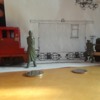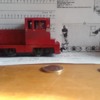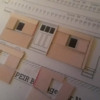Hi bigkid, leikec.
So let me ask you guys this, if you start with any gauge be it N,HO, O, G and in my case Lionel 3r trucks and you want that particular gauge to represent 3 foot how do you calculate the proportions of the engine and rolling stock to get that look i am after?
This info would be a tremendous help to me.
Stan
Hey Stan, it's really quite easy....................
Take the track gauge you want to represent (full size measurement) and divide it by the actual track gauge you have (also full size measurement). This will equal the scale factor. One very important note: Both figures you start with must be in the same measurements (i.e., inches to inches, feet to feet, millimeters to millimeters, yards to yards, miles to miles, etc., etc.)
Example #1: You want to model 3' narrow gauge, using some O-gauge 3-rail track, which is 1-1/4" between the rails. But first, we have to have "like" measurements. So you have a choice - you can use 3' as is, and convert the 1-1/4" to feet. Or, you can convert the 3' to inches (36"), and use the 1-1/4" as is. That sounds easier, so let's do that. 36" divided by 1-1/4" equals 28.8, your scale factor. 1/28.8, or 1/29 scale, rounded off.
Example #2: You decide instead to model 30" narrow gauge. You have standard O-scale 2-rail track, which is (surprise, surprise) 1-1/4" between the rails. Since we already have inches to inches, we can go ahead and figure. 30" divided by 1-1/4" equals 24, your scale factor. 1/24 scale, or......... 1/2" = 1'-0"!
Example #3: You decide you don't have a lot of room, and might want to go quite a bit smaller, let's say using N-scale track as 3' narrow gauge. We need to do some converting. N-scale track is 9 mm between the rails. Converting 9 mm to inches, we come up with .3543", just a little under 3/8". Now we can figure. 36" divided by .3543" equals 101.6, the scale factor. 1/101.6, or 1/102 scale, rounded off. Boy, we're gonna' have to scratch build everything if we want to stay true to that scale! Maybe we'd be better off by arbitrarily figuring 30" between the rails instead of 36"? Go ahead and do the math to see what scale factor we'd end up with. Think we'd be better off going that route? Would we be much closer to another popular scale, and not have to scratch-build everything on the layout? 
Hope this helps a little more. 







